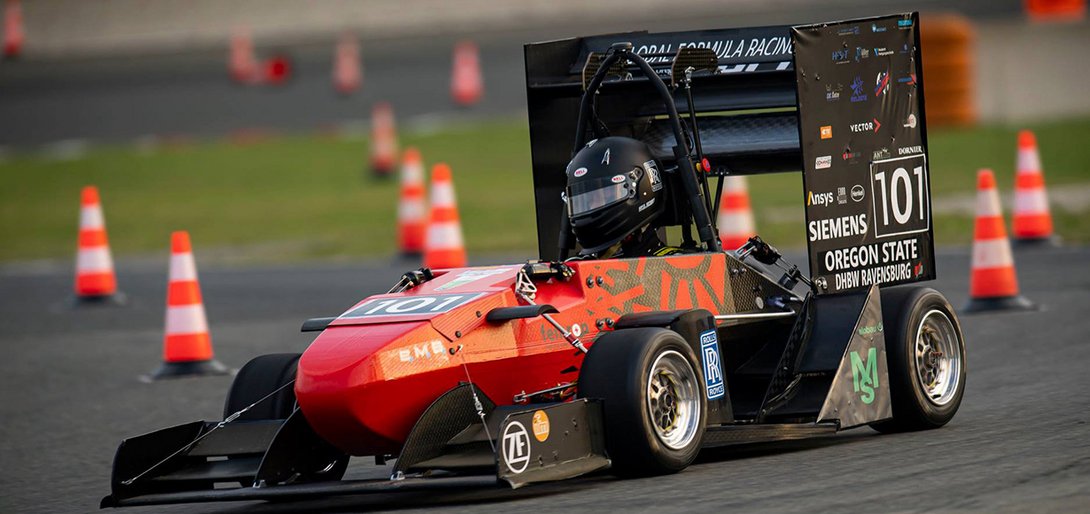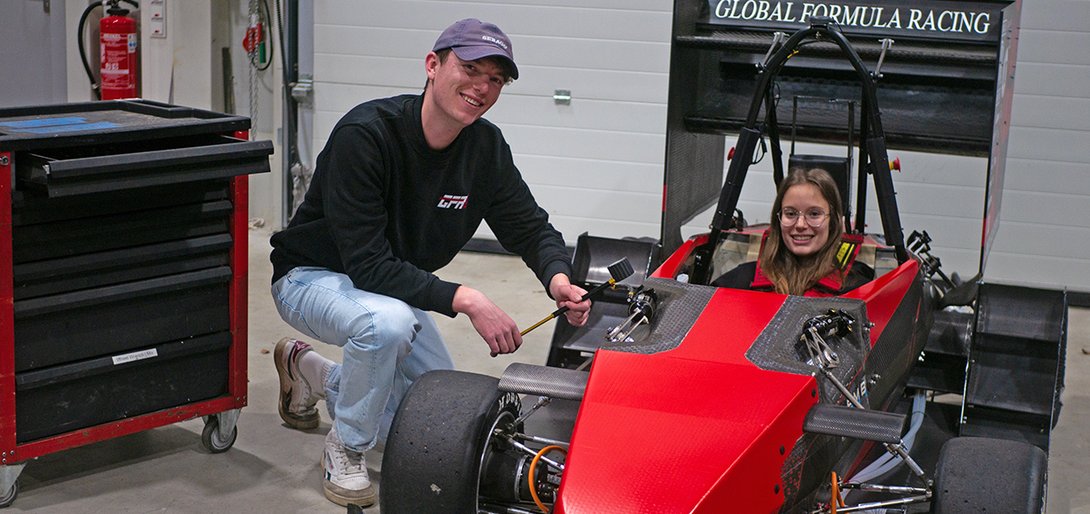Chiara Frankenbach, 22, has been part of the Formula Student Team at DHBW Ravensburg, Friedrichshafen Campus, since April 2021. At GFR, she was in charge of the "Aerodynamics" subteam until October and was also a driver last season.
Luis Retzbach, 21, has been a GFR member since January 2022 and is responsible for the chassis in the "Suspension" subteam. This brings the Formula 1 fan a good deal closer to his childhood dream of becoming a Ferrari mechanic one day.
Chiara, Luis, as GFR you've chosen the slogan "Two Nations. One Team. One Mission." because it says a lot about you. Tell us, what exactly?
Chiara: Within Formula Student, our racing team has a real unique selling point: Global Formula Racing is the only functioning team in the competition that consists of students from two nations. On the one hand, we here, who study at DHBW Ravensburg with Campus Friedrichshafen, and on the other hand, students from Oregon State University (OSU) in the USA.
Luis: And despite the 8,770 kilometres distance, 9 hours time difference and two different languages, we always manage to develop and produce two ready-to-use race cars together.
Chiara: Which even get better with every year! Of course, an optimised racing bolide with reduced weight and increased performance is our ultimate goal in order to finish at the front of the field in the competitions.
You say that your team works across the pond. How do you do that concrete terms?
Chiara: Google Meets, email, Google Chat and Spaces... we really use everything to exchange ideas. To do this, we have set regular meeting times that take place in the evenings here, in the US always in the morning. The whole thing works so well because the team at OSU is organised differently. You study full-time and therefore have fewer lectures in one day.
Luis: On the other hand, we adapt linguistically. We communicate with each other completely in English - also because that is the language of the Formula Student competition - which was really exhausting, especially at the beginning. But now we speak it all the better!
Do other advantages for your racing team result from the international interaction?
Luis: Competitive advantages, for sure! We compete in Formula Student with two cars, which gives us a tactical advantage over other teams.
Chiara: Although both racing cars have the same electric drive, we can participate in two different competition classes: autonomous and electric. In contrast, we no longer compete in the "combustion engine" class, even though we were top-ranked there. Today, it's the electric drive that counts and our American racing car is very strong in autonomous driving.
Two competition classes also mean a lot more work for you, for example in terms of organisation and coordination. Is that worth it?
Luis: We benefit as a team. We can divide our workforce between two cars and it takes the pressure off in terms of time. For example, when our autonomous model was already doing its first competition rounds in America in June, we were still able to work on our e-car with a high level of concentration on the German side of the team.
Chiara: Due to the staggered schedule, the OSU lecturer in charge even had time to congratulate us on our new car by video message on the day of our presentation. And many of the American team members have already flown to Germany with the car. It's a great feeling to be so closely connected!
You presented the new car to us, your other sponsors, friends and family in July. Not all of you could be there. So, please explain briefly what's new about it.
Chiara: This year, the aerodynamic changes stand out. For the first time since 2016, a DRS system has been developed again, which allows the driver to flatten some elements of the rear wing and the car drives with less drag on the straight - so it's faster. We have also rethought and developed aerodynamics on the front wing and the undertray.
Luis: And "Aerodynamics", Chiara's sub-team, not only develops the aerodynamic components, but also manufactures them from carbon.
Luis, and what tasks do the others in the team take on?
Luis: The "Epowertrain" subteam takes care of all the electronic components from the battery to the wiring harness, "Suspension" is responsible for the chassis, fpr example. steering, gas and brake systems, wheels and rims. Then there is "Autonomous", which is responsible for computer systems and sensors, for example, and the "Management" team.
Chiara: The latter is sometimes underestimated, but because of the two nations it is incredibly important for the smooth running. Without marketing, social media, team events and all the other things they do, basically nothing would work at GFR...
How incredibly much effort all that means! So please tell us one thing in conclusion: Why do you do it all?
Chiara: First and foremost to win! We work for months for the competitions, we just want to be the best. Preferably back to the top of the Formula Student world rankings.
Luis: That's our "one mission" that unites us as a GFR team. We simply work great together, so time differences and long transport routes are no obstacle.
And to be part of a team that built and assembled the 2022 race car from scratch makes me really proud. I've learned an incredible amount, especially in the areas of design, production technology and assembly. For example, I now know how to work properly with carbon and how to make aerodynamic parts from it.
Chiara: The construction of the aerodynamic components also fascinated me the most. There is virtually no aerodynamic part on the car that I don't know about or whose history of creation. It's great what we have achieved together - as a team. And I will always remember the nights spent fiddling around in the workshop.
All the time and hard work we put into the development and production of our racing car was definitely worth it. We are just proud of the results we achieved this year.
Luis: Without this unique team, the 2nd place at the end of the season in Spain, for example, would not have been possible - I am quite sure of that.
Thank you very much for the exciting insights!
Background:
The university competition Formula Student has become more and more popular since it was first officially held in 1979. In the meantime, more than 20 countries and more than 600 universities and colleges participate. The winner is not only the team with the fastest car, but rather the one with the best overall package of construction, performance as well as financial and sales planning. By participating in Formula Student, students gain experience in teamwork, time and project management, construction, manufacturing and in the economic aspects of automotive engineering. An idea that Waldner promotes and supports by sponsoring the GFR racing team and the dual students.

